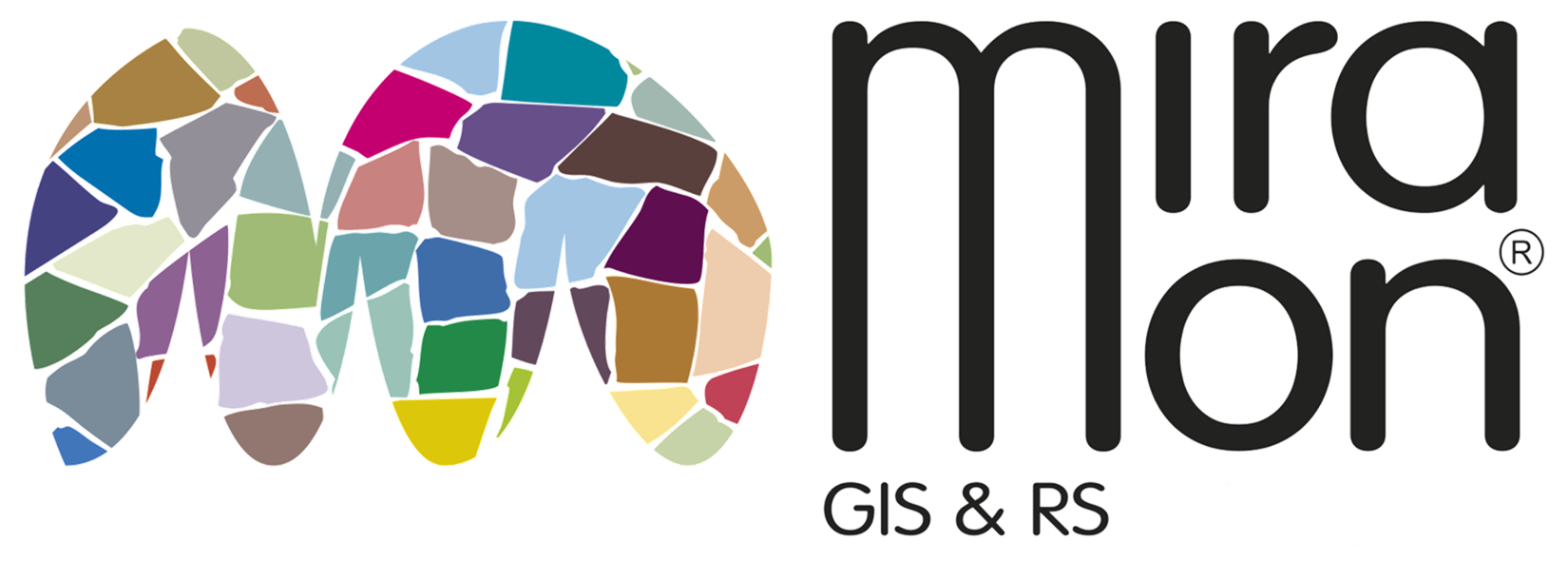
 |
Information menu |
Get raster/vector informationThis allows the user to make either a query by location of rasters and vectors, only loaded rasters or only loaded vectors. The cursor changes in appearance to indicate which query mode it is in. Pressing the F9 key has the same effect.
If you would like information about the result of the raster and vector query by location, go to Raster query and Vector query. Pre-info box (vectors)Prior to displaying the complete information about a consulted vector, but after highlighting it, MiraMon can show a little box that allows you to "continue searching" or "cancel"; this is useful when many and/or complex vector files are opened. 
This option can be activated by using the "PreInfoBox" parameter of the MiraMon.par file (it will be the default option), or through the "Pre-Info Box (vectors)" option in the Information menu. Open database tableThis allows you to open a database table of
a topologically structured vector file with MiraDades (Visualizer/Editor
of MiraMon databases). Another way of doing this is to make a query by
location and pressing the button 
Once the database table is open it is possible to carry out all the possible options with MiraDades. Query by attributes (where is ...)This allows you to query by attribute using any opened file, either raster or vector (structured). For conventional raster files, where each cell contains an attribute value (thematic class, height, slope, radiance, etc.), querying is done on these values. For structured vectors the query is done on a field of any database table. If the database has records not linked to graphic objects (the graphic identifier is a negative value or a number greater than n-1, n is the number of graphic objects in the file), these records are ignored. In polygon databases, the polygon 0 (the universal polygon) cannot be consulted. 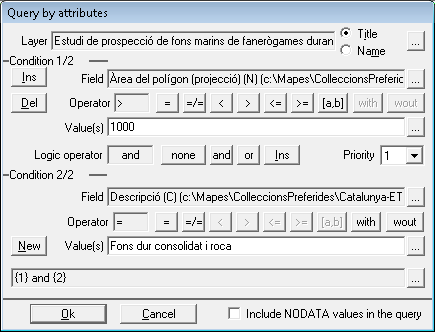
The query is done by first choosing the graphic file to consult, which can be visualized by Title or Name. Second, you choose the condition, choosing the field in which you want to make the query (if you are dealing with fields from different associated tables, all the fields appear in a list and the table to which the field belongs is indicated in brackets), the operator to apply and the values to query. The possible operations are: 
"Equal to", "different to", "lower than", "higher than", "lower or equal to", "higher or equal to", "between two values", "with" and "without" (respectively). The operators "with" and "without" apply to character chains, for example, you can search for all the cities with "Hill" in the name. MiraMon allows you to make queries with an unlimited number of conditions, and therefore you can use very sophisticated sentences. To introduce new conditions, press the logic operator you would like and the options of the second condition will be activated. If you want to introduce a condition before the first one, you should press "Ins". The new condition will be the first and the one that was previously defined will become the second condition. If you want to introduce a third condition, press the button "New". A system of priorities means you do not need to worry about unbalanced parentheses when there is more than two conditions. Suppose we have 3 conditions with the following operators: 1 or 2 and 3 Suppose that the query is carried out in a forest inventory, in which the first condition is that the species is "Pinus halepensis", the second condition is that the species is "Pinus pinea" and the third condition is that the percentage of cover is higher than 75%. If we give first priority to the first two conditions, the query is carried out in the following way: (1 or 2) and 3. 
Therefore, the points of the inventory where there are "Pinus halepensis" or "Pinus pinea" are selected, and that, independent of the specie, have a cover higher than 75%. However, if we give first priority to the second and third conditions (therefore, between the first and second condition there is second priority), the query is carried out in the following way: 1 or (2 and 3) 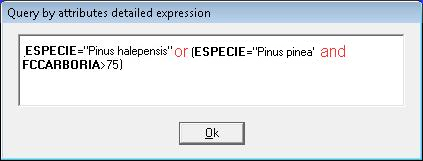
Therefore, all the points of the inventory where there are "Pinus halepensis" (with any percentage of cover) and the points of the inventory where there are "Pinus pinea" with a cover higher than 75% will be selected. The summary of the query is continually shown in the lower part of the queries by attribute box. The button of the three points located next to this summary box allows you to see the detailed expression of the query with enriched text. In a query with 5 conditions and the following priorities, the parenthesis system would be: Conditions and operators: 1 or 2 and 3 or 4 and 5 Priorities: 1 3 2 4 Results of the query: [(1 or 2) and (3 or 4)] and 5 Once you launch the question, MiraMon looks for the matching records in the raster files or databases, depending on the target file selected. If some entries are found, they are shown with the color indicated in "View | Selection color". A box also appears a box ("Query by attribute results") where you can check how many cells or pixels (raster) or graphic objects (vectors) have been found, how many database records have been found (vectors) (remember that MiraMon supports a single graphic object linked to several database records: for example different observation dates on the same point) and how many elements are visible in the current view. For raster files, when zoom is <1 the number of visible cells is only approximate. In the "Query by attribute results" box you can: 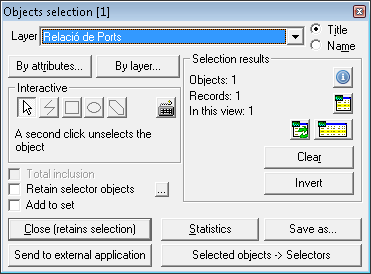
Selection by clic Selection by transect Selection by
rectangle/square Selection by
ellipse/circle Selection by irregular polygon

Selection by coordinate entry via
keyboard The box "Add to set" governs if we want to accumulate the selected objects, either interactively or by attributes. After any query by attribute, the Zoom menu
allows you to zoom to the selected objects, using the button "Zoom
to selection" ( Selection: cancel, statistics, exportThis allows direct access to the "Query by attribute results" box (cf. Query by attributes (where is ...) for more information) if in the previous query you have chosen "Close (keep selection)". This:
A quick way of accessing the query by
attribute box is with the icon Measure distance, perimeter, areaThis allows you to calculate the distance between two points, either in one segment or in various segments. For the latter, MiraMon allows you to find out the total length and the length of the last segment in map units. 
If you wish to know the area and the perimeter of a polygon, you should press the corresponding button. MiraMon will close the polygon automatically joining the first and last marked vertex, and calculate the corresponding Area and Perimeter. The button "New" allows you to start a new distance measurement. The button "Keep" allows you to return to the client window, keeping the segments used in the previous distance measurement. The button "Advanced" in the "Measurements" dialog box allows you to carry out the query in a temporary file, save it in a permanent file or erase it. If you choose to save the query in a temporary file, when you close the MiraMon session a message will appear asking you if would like to save the measurement in a file. 
The button "Computing method" in the "Advanced options of fast measurements" dialog box allows you to calculate the lengths, perimeters and areas on the cartographic projection or on the reference ellipsoid. MiraMon automatically applies the geodesic calculation (on the ellipsoid). 
A quick way of accessing the query by
attribute box is with the icon Crear annotationsAllows the user to incorporate annotations into one
map by inserting dots (with or without anchored text),
lines or polygons, which are modifiable, eliminable and
they can save on maps. This annotation tool is accessible
from the toolbar via the button Point type annotations
carry an associated symbol as well as an anchor
text. To choose symbol size is allowed (in screen pixels)
and the source of the text. There are three default symbols (circumference,
cross and balloon) and another symbol can be chosen through
the button 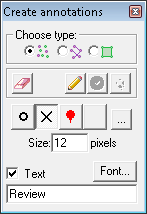
In line type annotations
the user can choose the color and thickness of the line. There are three colors and
thicknesses by default and others can be chosen through the
button 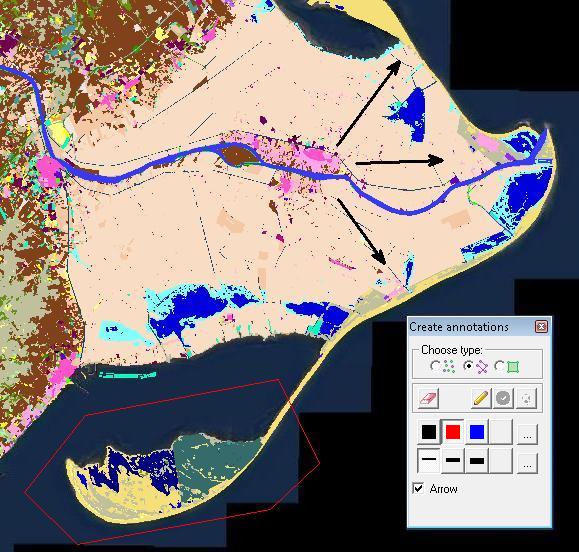
Polygon type annotations
allows the user to choose the color and transparency degree of polygons. There are three colors and transparencies by default
and others that can be chosen via the button 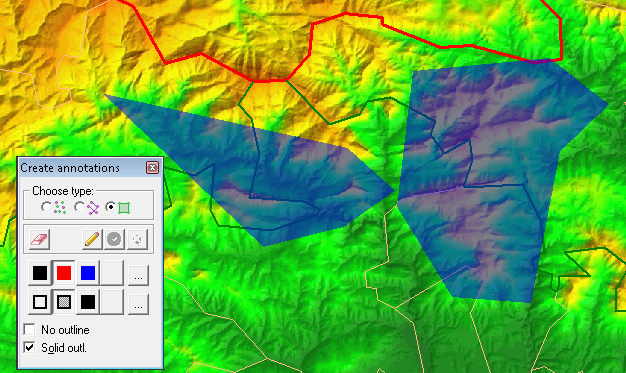
Annotations can be modified or delete once they have been created. To do this the user needs to access the Delete/Modify annotations button in the same window as annotations. 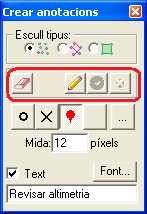
To delete an annotation it is necessary
to press the button with the delete icon ( 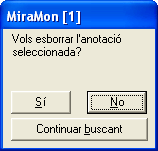
To modify an annotation it is necessary to
press the button with the modify icon ANSI/OEM character setThis allows you to work with the character sets of the plain text files and the database files with the ANSI 1252 set (used mainly in Europe and in the entire American continent) or the OEM-850 set (used approximately in the same geographic area). ANSI/OEM character set in plain text files: MiraMon assumes you always edit your plain text files (TXT, REL, DVC, etc) using the same text editor: a Windows editor using the ANSI 1252 set or a DOS editor using the OEM-850 set. Therefore, you can configure the program to interpret texts according to some of these character sets: "Treat text fields as Windows ANSI" or "Treat text fields as DOS OEM-850". If your accented characters are not displayed properly when you are displaying text (either in titles, legend, queries, etc), try to invert the ANSI/OEM criterion with |Information | ANSI/OEM Character set | and this will probably solve the problem. To establish the MiraMon default for this criterion use the parameter "JocCaracTXTPerDefecte" in the MiraMon.par file. 
If you have mixed ANSI and OEM files, a good idea would be to join them to one of the two sets by translating the files from the system that is considered to be less convenient (ANSI or OEM) into the desired one (ANSI or OEM). If you wish to convert your files permanently you can use the ANSIOEM program, shipped with MiraMon (or its Windows interface, accessible through "Tools | File maintenance"). Remember that to edit OEM texts you can use the DOS "EDIT" and that to edit ANSI texts you can use the Windows "NOTEPAD". ANSI/OEM character set in database files (DBF): Many DBF tables generated by modern programs have an internal mark indicating which character set is used. If this set is supported by MiraMon (most European and American languages) the right conversion is automatic and the table is always properly displayed. Nevertheless, you can also translate all your tables to an internally coherent character set by using the ANSIOEM program. However, this is not necessary for display purposes because MiraMon and MiraDades do the necessary conversions. ANSIOEM is accessible through "Tools | File maintenance". However, if the table has been generated using less modern software (such as dBASE III+), this mark may be missing (set=0) and the table is usually in the OEM-850 character set; if the table has been translated directly from some other software, it may also not be marked and is usually written in ANSI 1252 if it comes from a Windows software. In these cases you can switch from one system to the other to see which is the correct one (if any); once it is clear, mark the table to the appropriate type using the ANSIOEM program. After the table has been marked using a set recognized by MiraMon, it will be automatically displayed with the appropriate conversion. As mentioned before, you can always translate tables in order to join them internally to the same character set. MiraDades reports the character set in the header of each DBF table. To access it, open the DBF table (| Information | Open database table), and press "Information" button. 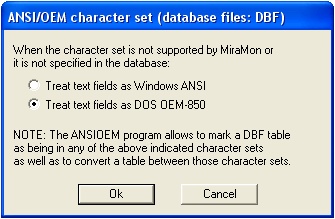
The "JocCaracDBFPerDefecte" parameter from the MiraMon.par file allows you to establish which conversion MiraMon applies to the non-marked tables (set=0) or to the tables marked with a set that is not known by MiraMon. Show coordinates and colorsThis turns a dialog box showing information about the central point of the cursor or on off. This information includes the coordinate [columns, rows] (only raster maps) and [X, Y] and [longitude, latitude] (raster and vector maps) and also the RGB values of the pixel's color on screen and the index in the color symbolization table that is currently active (shown in brackets). When there is no color palette loaded, or when there are only palettes associated with vectors, a dash [-] will be shown at the index position. A pixel's RGB value is shown as P25 palette indices. [longitude, latitude] coordinates only appear if the reference system is known by MiraMon. You can set which kind of coordinates you wish to see with "Information | Advanced options". 
The initial position and dimensions of the coordinates box can be defined through the "AmpleCaixaCoord" parameters of the MiraMon.par file. You can resize the window (useful when the coordinates fill a lot of figures or when you want to save screen space) and it can be located where it is most useful for you. Keep in mind that the drawing scrolls may become slower if you set it inside the map area. This is because drawing scrolls have to "skip" the obstacle. The amount of coordinate figures [X, Y] is determined by the "MostrarCoordenades" parameter of the MiraMon.par file or through "Information | Advanced options". As displaying coordinates continuously can affect multitask processes negatively (the computer works slower), we suggest that when executing background programs, it is better to close the coordinates display while you do not need it. Moreover, if your CPU is not very fast, cursor redrawing (when moving it) is finer when you have the coordinates turned off. You can also turn this window on and off by pressing the F6 key.
WARNING: When you display a raster map, the index of the color palette is only the same as the value in the file if the map is bit, byte or byte-RLE and you have a graphic board that can show at least 32768 simultaneous colors. On 256-color graphic boards there may be some changes, in a maximum of 20 of the 256 colors. Examples: 1/ Regardless of your graphic board, if you want to find out the value of a cell in an integer file you consult it using the left mouse button, so that the value is read on the file, and not on the graphic board. 2/ If your graphic board can only show 256 colors simultaneously and you are displaying a byte file that shows pixels with all values, there will be some colors (20 at the most) represented with a palette index that may be different from the file value. This is because Windows reserves some colors for the title bars and other parts of the display: if you need 256 colors and some of them are not the ones preserved by Windows, it means that you are asking for more than the 256 colors supported by your system; Windows adapts (scans) the "excess" colors to a similar color of the 256 ones that it can load; when displaying images with a grey palette this means that some greys are seen as pale yellows. Show legendThis turns a floating window showing the
title and the legend of the raster map you are displaying on and off. To
save space on the screen, only 16 categories are shown, but if the legend
has more than 16 classes, the Modify layer order and propertiesAllows you to change the order (vertical) of the layers or groups of layers shown. It also allows you to change their properties (visible, consultable, copiable when digitizing, etc). For more information consult Modify layer order and properties in view menu. Legend defaultsThis allows you to show the color visualization in the legend as the color indices of the categories or as the indices of the links with categories, when the layer does not have the visualization conditions in the legend defined in the REL file or the MMM. Show GPS trackThe GPSMM module that is available in the menu "Tools | GPSMM" allows you to take data from a GPS connected to the computer (usually a laptop) and generate a PNT or a screen dump. Using the option "Show GPS tracking" you can see the GPS data in real time in the MiraMon window and follow up of selected objects (either by attributes or interactively) that change the position in space ("map moving") or its attributes. This typically allows track objects from a base updating, either in position or content (e.g. see the position of fire engines that are acting in a fire) and of which the position is updated periodically. At the same time too you will be able to manage the various types of regular refreshment and follow-up of layers (including that of GPS). Finally, it is also possible that the layers with periodic refresh maintain their selection of objects in case it exists. GPS tracking parametersWhen you are capturing data from a GPS connected to the computer you can define the percentage of the screen that you don't need re-centered. With a value of 0%, each new point that is captured will be re-centered. With a value of 100% the new point is only re-centered when it goes off the screen. The value is automatically 80%. You can also define the radius of the GPS tracking zone, that is the radius of the circle drawn on the edge of the arc of the path when tracking with the GPS in real time, which can be defined in pixels or in map units. 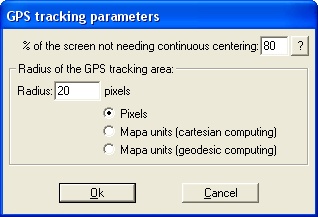
Current reference systemAllows you to access the information about the parameters of the reference system used in the files which are currently active. 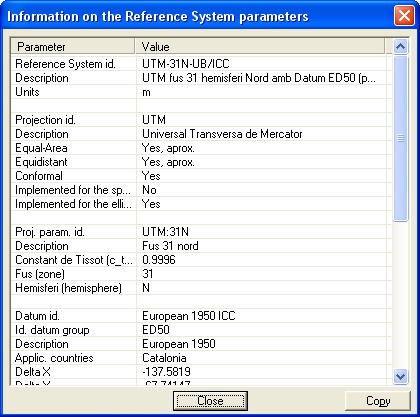
Information is given about the following parameters: the identifier of the reference system (with the description and its units), the cartographic projection (identifier, description, if dealing with an equivalent projection, equidistant, conform, etc), the projection parameters (zone, hemisphere, Tissot constant, etc), the parameters of the data (identifier, description, application locations, etc) and the parameters of the ellipsoid (identifier, description, type, equatorial radius, etc). For more information consult MiraMon horizontal reference systems. Opened mapsThis lists the MiraMon Maps (*.MMM) that are currently loaded and their titles. 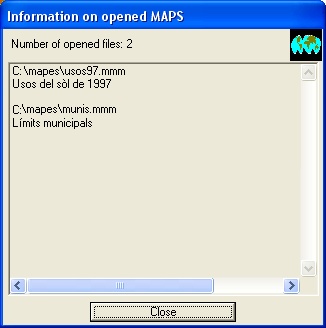
Opened rastersThis gives the essential characteristics of the currently opened rasters that we are displaying through the "File | Opened raster" option as well as the ones we are displaying through "File | Opened map". Among other characteristics, information is given on the database distributor, the title, the file type, the number of columns, the raster limits, etc. From the information window on opened rasters you can access their Metadata. 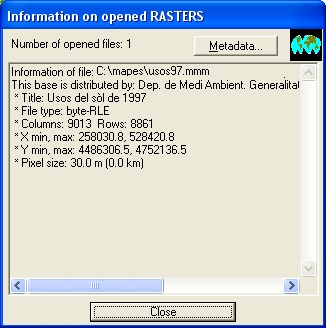
Opened WMS/WMTS layersThis gives the essential characteristics of the WMS layers currently open. This provides information about the source of the WMS layer, the title, the format, and other factors. 
Opened vectorsThis gives the essential characteristics of the currently opened rasters that we are displaying through the "File | Open vector..." option as well as the ones we are displaying through "Edit | Digitize/Edit vector" or through "File | Open map". It also gives information about the type of graphic object of each file and about the characteristics selected for its display (color, text, etc.). 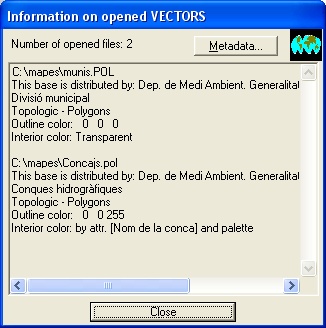
Opened seriesIt gives the essential features of the currently open cartographic series. Among other features, the number of open series, the identifier of each series, the title, the number of open sheets in each series, etc. are reported. Opened palettes and symbolization tablesThis gives the name and the number of colors of the currently loaded palettes. If these palettes have been resized to adapt them to the raster or vectors, the number of colors will be equal to the new number. If a palette has been changed using the color editor or due to image enhancement processes, MiraMon will also indicate this. 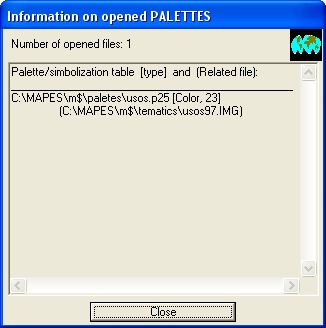
Advanced optionsThis allows you to define some of the parameters shown in the information about the layers, such as the number of decimal figures of the coordinates, the reference system units, the format of the longitude-latitude coordinates, the number of decimal figures in queries and statistics, etc. 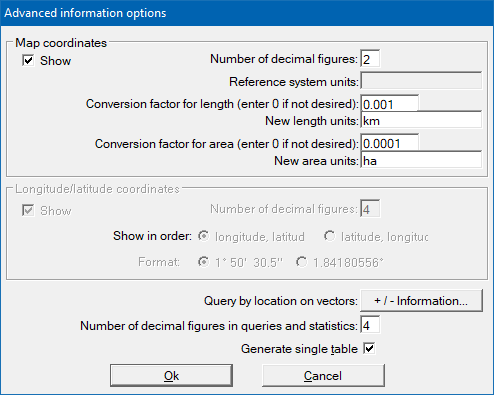
|